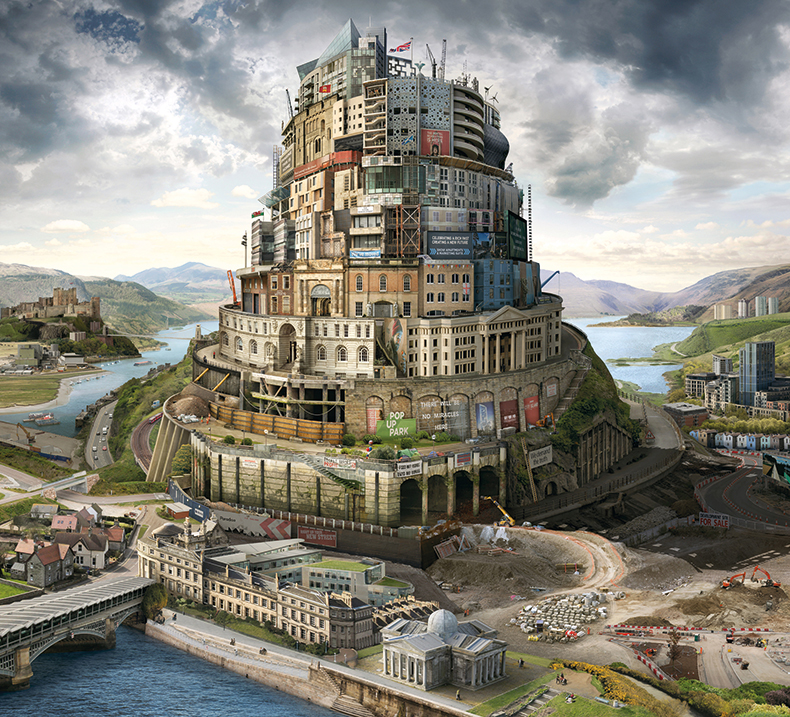From the April 2023 issue of Apollo. Preview and subscribe here.
It may have disappeared – it may never have existed – but it continues to loom large. The story from Genesis hardly needs repeating: after Noah, all humans had the same language, and many gathered on the plain of Shinar to build ‘a tower with its top in the heavens’. Irate at this presumption – and possibly alarmed at what united humanity might get up to next – God punished the builders by confusing their language, so that they could not understand one another, terminating the project. It is a classic template of human pride and divine retribution, hubris written in stone and then a nemesis of division and incomprehension. It is a warning, as Milton wrote, that the ‘greatest Monuments of Fame, / And Strength and Art are easily out-done / By Spirits reprobate’. But, remaining forever unfinished, the Tower of Babel is a structure to which artists appear compelled to return.
Two recent novels feature the tower in radically different guises. Brian Catling’s Hollow (2021) includes in its extraordinary imagery a ruinous Tower of Babel slowly being absorbed into the landscape it dominates, an anomalous snow-capped peak in the Low Countries. Why there and not the plain of Shinar? Because that is where the tower is sited not by the biblical king Nimrod, but by Pieter Bruegel the Elder. Hollow is a novel steeped in art history, in which the creations of Bruegel and Bosch have taken on earthy, baffling life; and it shows that the biblical tower and Bruegel’s tower have become inseparable.
The tower is even more prominent in R.F. Kuang’s bestselling Babel (2022). In this modern fantasy, it is relocated to an alternative Oxford, where it stands over James Gibbs’s and William Townesend’s Radcliffe Camera, from which it has drawn obvious inspiration. Kuang’s Babel is the linchpin of the magic system of her world, which resides in a relationship between the translation of words and the working of silver. It is also a visible expression of a strictly hierarchical society – and a kind of broadcasting mast.
The Tower of Babel (1563), Pieter Bruegel the Elder. Kunsthistorisches Museum, Vienna. Photo: © KHM-Museumsverband

Bruegel painted two Towers of Babel, both in 1563. The larger and more famous of the two, kept at the Kunsthistorisches Museum in Vienna, depicts a slightly smaller edifice in a distinctly less complete state. It also seems that the Vienna tower is getting some assistance from the terrain, as it appears to be constructed around a natural rock formation. The smaller panel, which is at the Museum Boijmans Van Beuningen in Rotterdam, has a larger and more architecturally finessed tower, with a more pronounced spiral ramp, one of the main impressions the imagined tower seems to trail with it. Across both, however, the architecture is distinctly crude, a blunt Romanesque of endless repeated round arches. This is a paradoxically realist touch in these fantastical views. Adornment is subordinated to the structural demands of the massive tower; the weight of the building is palpable.
Bruegel made the tower into a mini-genre in Flemish art: there is a little Canary Wharf of Babels by artists including Marten van Valckenborch (1535–1612), Tobias Verhaecht (1561–1631) and Roelant Savery (1576–1639) – artists who, like Bruegel, made repeat visits to the tower. This tradition continues into our age. As a teenager I had on my wall a poster from the Centre Pompidou in Paris, featuring a painting by Dominique Appia of the tower as a railway interchange. The artist Emily Allchurch has, since 2005, made a series of Towers of Babel using photography and digital collage, constructing each with elements of a specific place, such as Hong Kong, Oslo or Britain – the last of which was recently used as the cover of Sam Byers’s novel Perfidious Albion (2018).
Babel Britain (after Verhaecht) (2017), Emily Allchurch. Courtesy James Freeman Gallery; © Emily Allchurch

Today the tower belongs more to Bruegel than to Genesis. Certain elements invented by him – such as the bustling wharf at the tower’s foot – have become inseparable from our conception of it. And with this, the divine punishment part of the story has somewhat receded into the background, even if we know it is around the corner. Bruegel’s towers are still very much in progress, not yet cursed with incomprehension or embarked on ruin. They swarm with activity and industry: indeed, that is one of their most remarkable and charming features, the wealth of insight they – the larger painting in particular – provide into 16th-century building. Dozens of different jobs, techniques, work-sites and tools are depicted. The details that capture the eye are all construction-related: the masons heaving slabs of stone, the various cranes, wheels and hoists, the bricks laid out on the wharf, the wooden formwork under half-built arches, the crude huts of the workers, the protruding teeth of the unfinished stone facade.
Perhaps all this industry hints at a basis for the Babel myth. In The City in History (1961), Lewis Mumford made the connection between the development of the ancient city and the development of specialised professions. This early division of labour pushed forward human prosperity, but also condemned people to lives spent doing one kind of work, a fact that makes Mumford curiously gloomy, compared to the (imagined?) generalism and liberty of more primitive existence. Subdivided man, Mumford wrote, ‘forfeited the unconscious wholeness of the simpler village type’, but what emerged from the chrysalis of tribe and clan was ‘a new sense of individual personality’. This is not unlike the splintering of languages and cultures described in Genesis – but it is a division we can look upon with more satisfaction, as an important part of the human story.
This thread of specialism brings to mind the different arcane purposes housed on the different levels of Kuang’s Oxford tower. Curiously, Kuang’s tower is complete – curious because it may be that the incompletion of the tower is the reason artists can’t help but return to it. In Tom McCarthy’s novel Satin Island (2015), the tower is used as a logo by a think tank for precisely this reason. The tower, a character explains,
only becomes of interest once it has flunked its allotted task. Its ruination is the precondition for all subsequent exchange, all cultural activity. And, on top of that, despite its own demise, the tower remains: you see it there in all the paintings – ruined, but still rising with its arches and its buttresses, its jagged turrets and its rusty scaffolding. What’s valuable about it is its uselessness. Its uselessness sets it to work: as symbol, cipher, spur to the imagination, to productiveness.
The tower remains art’s greatest work in progress.
From the April 2023 issue of Apollo. Preview and subscribe here.


